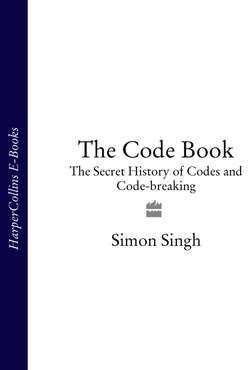The Code Book: The Secret History of Codes and Code-breaking

Реклама. ООО «ЛитРес», ИНН: 7719571260.
Оглавление
Simon Singh. The Code Book: The Secret History of Codes and Code-breaking
The Code Book. The Secret History of Codes and Codebreaking. Simon Singh
Copyright
Dedication
Epigraph
Contents
Introduction
1 The Cipher of Mary Queen of Scots
2 Le Chiffre Indéchiffrable
3 The Mechanisation of Secrecy
4 Cracking the Enigma
5 The Language Barrier
6 Alice and Bob Go Public
7 Pretty Good Privacy
8 A Quantum Leap into the Future
If you enjoyed The Code Book, check out these other great Simon Singh titles
The Cipher Challenge
Appendix A
Appendix B
Appendix C
Appendix D
Appendix E
Appendix F
Appendix G
Appendix H
Appendix I
Appendix J
Glossary
Further Reading
Picture Credits
Searchable Terms
Acknowledgements
About the Author
Other Books by Simon Singh
About the Publisher
Отрывок из книги
For my mother and father,
Sawaran Kaur and Mehnga Singh
.....
At this point, we have confidently identified two of the letters in the ciphertext. Our conclusion that X = a is supported by the fact that X appears on its own in the ciphertext, and a is one of only two English words that consist of a single letter. The only other letter that appears on its own in the ciphertext is Y, and it seems highly likely that this represents the only other one-letter English word, which is i. Focusing on words with only one letter is a standard cryptanalytic trick, and I have included it among a list of cryptanalytic tips in Appendix B. This particular trick works only because this ciphertext still has spaces between the words. Often, a cryptographer will remove all the spaces to make it harder for an enemy interceptor to unscramble the message.
Although we have spaces between words, the following trick would also work where the ciphertext has been merged into a single string of characters. The trick allows us to spot the letter h, once we have already identified the letter e. In the English language, the letter h frequently goes before the letter e (as in the, then, they, etc.), but rarely after e. The table below shows how frequently the O, which we think represents e, goes before and after all the other letters in the ciphertext. The table suggests that B represents h, because it appears before O on 9 occasions, but it never goes after it. No other letter in the table has such an asymmetric relationship with O.
.....